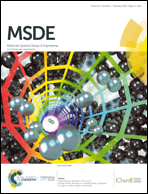A bio-inspired approach to engineering water-responsive, mechanically-adaptive materials†
Abstract
Inspired by a diverse array of hierarchical structures and mechanical function in spider silk, we leverage building blocks that can form non-covalent interactions to develop mechanically-tunable and water-responsive composite materials via hydrogen bonding modulation. Specifically, self-assembling peptide blocks consisting of poly(β-benzyl-L-aspartate) (PBLA) are introduced into a hydrophilic polyurea system. Using these peptide–polyurea hybrids (PPUs) as a hierarchical matrix, cellulose nanocrystals (CNCs) are incorporated to diversify the self-assembled nanostructures of PPUs through matrix–filler interactions. Our findings reveal that higher PBLA content in the PPUs reduces the magnitude of the stiffness differential due to the physical crosslinking induced by the peptide blocks. Additionally, the inclusion of CNCs in the PPU matrix increases the storage modulus in the dry state but also diminishes the wet-state modulus
due to the shift of physical associations from peptidic arrangements to PBLA–CNC interactions, resulting in variations in the morphology of the PPU/CNC nanocomposites. This molecular design strategy allows for the development of adaptable materials with a broad range of water-responsive storage modulus switching
, spanning from ∼70 MPa to ∼400 MPa. This investigation highlights the potential of harnessing peptide assembly and peptide–cellulose interactions to achieve mechanical enhancement and water-responsiveness, providing insights for engineering next-generation responsive materials.


 求助内容:
求助内容: 应助结果提醒方式:
应助结果提醒方式:


